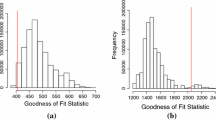Abstract
Data in the form of zero-one matrices where conditioning on the marginals is relevant arise in diverse fields such as social networks and ecology; directed graphs constitute an important special case. An algorithm is given for the complete enumeration of the family of all zero-one matrices with given marginals and with a prespecified set of cells with structural zero entries. Complete enumeration is computationally feasible only for relatively small matrices. Therefore, a more useable Monte Carlo simulation method for the uniform distribution over this family is given, based on unequal probability sampling and ratio estimation. This method is applied to testing reciprocity of choices in social networks.
Similar content being viewed by others
References
Achutan, N., Rao, S. B., & Rao, A. R. (1984). The number of symmetric edges in a digraph with prescribed out-degrees. In K. S. Vijayan & N. M. Singhi (Eds.),Combinatorics and applications, proceedings of the seminar in honour of Professor S. S. Shrikhande (pp. 8–20). Calcutta: ISI.
Békéssy, A., Békéssy, P., & Komlos, J. (1972). Asymptotic enumeration of regular matrices.Studia Scientiarum Mathematicarum Hungarica, 7, 343–353.
Bender, E. A. (1974). The asymptotic number of non-negative integer matrices with given row and column sums.Discrete Mathematics, 10, 217–223.
Cochran, W. G. (1977).Sampling techniques (3rd ed.). New York: Wiley.
Connor, E. F., & Simberloff, D. (1979). The assembly of species communities: Chance or competition?Ecology, 60, 1132–1140.
Fershtman, M. (1985). Transitivity and the path census in sociometry.Journal of Mathematical Sociology, 11, 159–189.
Fulkerson, D. R. (1960). Zero-one matrices with zero trace.Pacific Journal of Mathematics, 10, 831–836.
Gale, D. (1957). A theorem on flows in networks.Pacific Journal of Mathematics, 7, 1073–1082
Hammersley, M. J., & Handscomb, D. C. (1964).Monte Carlo methods. London: Methuen.
Holland, P. W., & Leinhardt, S. (1970). A method for detecting structure in sociometric data.American Journal of Sociology, 76, 492–513.
Holland, P. W., & Leinhardt, S. (1975). Local structure in social networks. In D. Heise (Ed.),Sociological Methodology, 1976 (pp. 1–45). San Francisco: Jossey-Bass.
Holland, P. W., & Leinhardt, S. (1979). Structural sociometry. In P. W. Holland & S. Leinhardt (Eds.),Perspectives on social network research (pp. 63–83). New York: Academic Press.
Holland, P. W., & Leinhardt, S. (1981). An exponential family of probability distributions for directed graphs.Journal of the American Statistical Association, 76, 33–50.
Katz, L., & Powell, J. H. (1954). The number of locally restricted directed graphs.Proceedings of the American Mathematical Society, 5, 621–626.
Katz, L., & Powell, J. H. (1957). Probability distributions of random variables associated with a structure of the sample space of sociometric investigations.Annals of Mathematical Statistics, 28, 442–448.
Katz, L., Tagiuri, R., & Wilson, T. R. (1958). A note on estimating the statistical significance of mutuality.The Journal of General Psychology, 58, 97–103.
Katz, L., & Wilson, T. R. (1956). The variance of the number of mutual choices in sociometry.Psychometrika, 21, 299–304.
Lehmann, E. L. (1986).Testing statistical hypothesis (2nd ed.). New York: Wiley.
Rao, A. R., & Bandyopadhyay, S. (1987). Measures of reciprocity in a social network.Sankhya, Series A, 49, 141–188.
Rao, A. R., & Rao, S. B. (1988).Measuring reciprocity in weighted social networks (Technical Rep. No. 20/88). Calcutta: ISI.
Ryser, H. J. (1957). Combinatorial properties of matrices of zeros and ones.Canadian Journal of Mathematics, 9, 371–377.
Snijders, T. A. B. (1990). Testing for change in digraphs at two time points.Social Networks, 12, 359–374.
Strauss, R. E. (1982). Statistical significance of species clusters in association analysis.Ecology, 63, 634–639.
Sukhatme, P. V. (1938). On bipartitional functions.Philosophical Transactions of the Royal Society of London, Series A, 237, 375–409.
Verbeek, A., & Kroonenberg, P. M. (1985). A survey of algorithms for exact distributions of test statistics inr byc contingency tables with fixed margins.Computational Statistics and Data Analysis, 3, 159–185.
Wasserman, S. S. (1977). Random directed graph distributions and the triad census in social networks.Journal of Mathematical Sociology, 5, 61–86.
White, H. C., Boorman, S. A., & Breiger, R. L. (1976). Social structure from multiple networks, I: Block-models for roles and positions.American Journal of Sociology, 81, 730–779.
Wilson, J. B. (1987). Methods for detecting non-randomness in species co-occurrences: A contribution.Oecologia, 73, 579–582.
Wong, G. Y., & Yu, Q.-Q. (1989). Computation and asymptotic normality of maximum likelihood estimates of exponential parameters of thep 1 model. Paper presented at The Stockholm Conference on Random Graphs and Applications, University of Stockholm.
Author information
Authors and Affiliations
Additional information
The author wishes to thank Cajo ter Braak and John Birks for pointing out the relevance of this subject for ecology; and also Albert Verbeek and Ivo Molenaar, a referee, the Editor, and the Associate Editor for their comments. An earlier version of this paper was presented at the Stockholm Conference on Random Graphs and Applications (April 25–27, 1989), organized with financial support from the Swedish Council of Research in the Humanities and the Social Sciences.
Rights and permissions
About this article
Cite this article
Snijders, T.A.B. Enumeration and simulation methods for 0–1 matrices with given marginals. Psychometrika 56, 397–417 (1991). https://doi.org/10.1007/BF02294482
Received:
Revised:
Issue Date:
DOI: https://doi.org/10.1007/BF02294482




